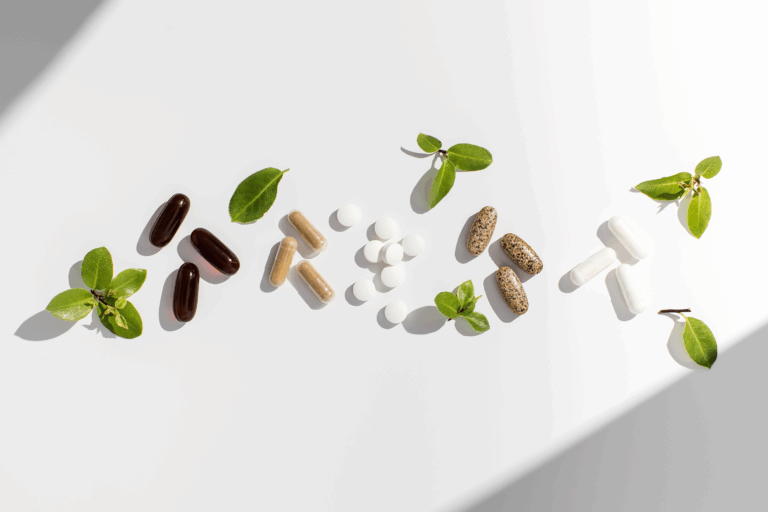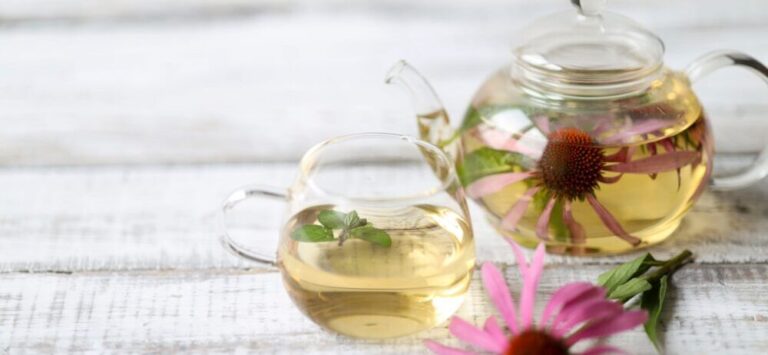What Does Ginseng Do?
Health Benefits of Ginseng
Although ginseng is one of the most popular herbs in the world, it is also often the most easily misrepresented within the herbal marketplace. Confusion abounds when it comes to naming herbs as “ginseng” — often in a disingenuous attempt to capitalize on the plant’s ancient reputation of powerful health-enhancing effects. In reality, there is a finite number of “true” ginsengs that are defined based on a shared botanical ancestry and phytochemical profile.
In Chinese, Ginseng roughly translates to ren-shen or “man-root” in part because when harvested, the branching roots are thought to resemble the form and/or essence of a human body. Ginseng root has been used as a folk medicine throughout Asia for thousands of years, mainly as a general tonic to maintain the body’s resistance to stress and improve physical and sexual function, longevity, and vitality.
What is “True” Ginseng?
Strictly speaking, plants which may legitimately be termed “ginseng” are those that are both of the Araliaceae family and Panax genus, of which many roots will contain significant amounts of constituents called ginsenosides (sometimes panaxosides), which are important for their medicinal effects.
Panax is derived from the Greek “pan,” meaning all, and “akos,” meaning remedy — referencing its reputation as a panacea, or “cure-all” medicinal herb. DNA analysis reviewing the evolutionary development and relationships among Panax species has established that there are less than a dozen known species of Panax in the world, with the most important widely considered to be Panax ginseng and Panax quinquefolius.1,2
Is Eleuthero Considered “Real” Ginseng?
An example of a commonly misnamed “ginseng” is “Siberian ginseng,” now known by the common name eleuthero (Eleutherococcus senticosus), which is also a member of the Araliaceae family and shares similar adaptogenic effects to other Panax species.
Health Benefits of Ginsenosides
The major bioactive components of P. ginseng and other ginseng species are the ginsenosides, which belong to a group of constituents called triterpenoid saponins. At least 50 different ginsenosides have been identified, and they are named according to their aglycone (sugar attachment) such as Rx (x = o, a1, a2, b1, b2, b3, c, d, e, f, g1, g2, h1, and h2).3 They are often referred to as either protopanaxatriols (consisting mainly of Rg1, Rg2, Rf, and Re) or protopanaxadiols (consisting mainly of Rc, Rd, Rb1, and Rb2).4,5
The structural diversity of ginsenosides and the different ratios found within ginseng species likely contribute to the herb’s varying pharmacological effects and play a role in its ability to support and prevent cardiovascular, inflammatory, neurological, and metabolic disease states.4 Therefore it is likely that a synergy or mixture of ginseng components can maximize health benefits and provide optimal physiological effects.4
Ginsenosides are also known to have poor bioavailability and likely do not remain in their active forms after oral doses are consumed. They are known to undergo structural conversion under high temperature and acidic conditions (such as steaming of Red Ginseng and/or within the body’s gastrointestinal tract), and the absorbed products that have been metabolized by intestinal bacteria are likely their most active forms.4,6
Comparison of “True” vs. Misnamed Ginsengs
| Common Name | Latin name | Family | Panax species? (Y/N) | Contains ginsenosides?(Y/N) | Native range |
| Korean, Chinese (Ren shen), or Asian Ginseng | Panax ginseng | Araliaceae | Y | Y | China, Korea, Eastern Russia |
| American or North American Ginseng (Hua Qi Shen) | Panax quinquefolius | Araliaceae | Y | Y | North America |
| Chinese or South China Ginseng (Tienchi or Sanchi) | Panax notoginseng* | Araliaceae | Y | Y | East Asia (China & the Himalayas) |
| Japanese Ginseng | Panax japonicus | Araliaceae | Y | Y | East Asia (China & Japan) |
| Siberian or Russian ginseng | Eleutherococcus senticosus | Araliaceae | N | N | Eastern Russia, China and Japan. |
| Indian/Ayurvedic ginseng or Ashwagandha | Withania somnifera | Solanacae | N | N | Mediterranean, Africa, India, Sri Lanka and southern China. |
| Malaysian ginseng or Tongkat Ali | Eurycoma longifolia | Simaroubaceae | N | N | Southeast Asia |
| Peruvian Ginseng or Maca | Lepidium meyenii | Brassicaceae | N | N | Peru (Central Andes) |
| Southern Ginseng Gynostemma (jiao gu lan) | Gynostemma pentaphyllum | Cucurbitaceae | N | Y | Southeast Asia |
| Poor Man’s Ginseng | Codonopsis pilosula | Campanulaceae | N | N | China (Central) |
*Previously known as Panax pseudoginseng
**G. pentaphyllum is the only non- Panax species known to contain these compounds.
Panax ginseng: Korean, Chinese, or Asian Ginseng
The history of P. ginseng as a medicinal herb extends back more than 5000 years when it was discovered in the mountains of Manchuria and has since been utilized as a potent “Qi” tonic in Traditional Chinese Medicine (TCM).7
According to TCM, P. ginseng has a warming nature and is considered to stimulate and invigorate “yang” energy. It is used to combat fatigue, strengthen “Qi” in the spleen, heart, and lungs, promote the production of body fluids, calm the mind, and improve cognitive functions.
In more modern terms, P. ginseng is considered a potent adaptogen given to promote stamina, increases resistance to disease, reduce physical and mental fatigue, and to enhance both cognitive and sexual function. Clinical trials have also shown it to be particularly beneficial for blood glucose control, restoring central nervous system and cerebrovascular function, and preventing acute pulmonary disease.4
Panax quinquefolium: American or North American ginseng
Native to the eastern United States and Canada, P. quinquefolium has a long history of use by its native peoples for symptoms such as shortness of breath, cough, digestive upset, headache, fatigue, female reproductive concerns, and general weakness. The Eclectic physicians used this herb as a bitter digestive tonic to enhance digestion and the absorption of nutrients.
TCM views P. quinquefolium as a cooling “Yin” tonic, with more calming effects when compared to P. ginseng. Both are considered aphrodisiacs and reproductive tonics to increase energy and libido, and they are also used in the treatment of cough, shortness of breath, and fatigue. Though the two ginsengs share some similarities, such as replenishing Qi, P. quinquefolium is considered more useful for treating acute stress, nourishing yin, clearing heat, and delivering to the kidney, lung, and heart meridians.9
Comparison of Korean/Asian Ginseng vs. North American Ginseng:9
| Panax ginseng | Panax quinquefolium | |
| Native Habitat | China, Korea, Eastern Russia | North America |
| TCM Energetics | Warming Yang Tonic Enters lung, heart & spleen channels | Cooling Yin Tonic Enters lung, heart & kidney channels |
| Primary Ginsenosides | Rg1 Rb2 Rc | Rb1 Re Rd |
| Key actions | Qi Tonic & Adaptogen Nervine Stimulant | Qi Tonic & Adaptogen Nervine Relaxant/Sedative Hypotensive |
- Wen, J., & Zimmer, E. A. (1996). Phylogeny and biogeography ofPanaxL.(the ginseng genus, Araliaceae): inferences from ITS sequences of nuclear ribosomal DNA. Molecular phylogenetics and evolution, 6(2), 167-177.
- Duke, J. A. (1989). Ginseng: a concise handbook. Reference Publication. Inc. Algonac. Mississippi. USA.
- Ru, W. et al. Chemical constituents and bioactivities of Panax ginseng (C. A. Mey.). Drug Discov Ther. 2015 Feb;9(1):23-32.
- Wee, J. et al. Biological Activities of Ginseng and Its Application to Human Health. In: Benzie IFF, Wachtel-Galor S, editors. Herbal Medicine: Biomolecular and Clinical Aspects. 2nd edition. Boca Raton (FL): CRC Press/Taylor & Francis; 2011. Chapter 8.
- Christensen, L. P. (2008). Ginsenosides: chemistry, biosynthesis, analysis, and potential health effects. Advances in food and nutrition research, 55, 1-99.
- Marciano, Botanical Medicine Manual, Prohealtsys Pub. 2019.
- Nair, R., Sellaturay, S., & Sriprasad, S. (2012). The history of ginseng in the management of erectile dysfunction in ancient China (3500-2600 BCE). Indian journal of urology: IJU: journal of the Urological Society of India, 28(1), 15.
- Lee, N. H., & Son, C. G. (2011). Systematic review of randomized controlled trials evaluating the efficacy and safety of ginseng. Journal of acupuncture and meridian studies, 4(2), 85-97.
- Chen, C. et al. (2008). Comparison of the pharmacological effects of Panax ginseng and Panax quinquefolium. Acta Pharmacologica Sinica, 29(9), 1103-1108.







